《数值分析》课程教学资源(课外阅读)G. H. Golub, History of Numerical Linear Algebra, a Personal View, 2007
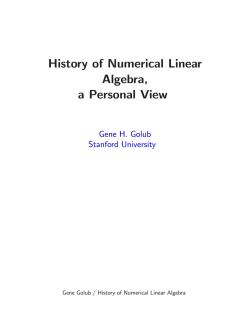
History of Numerical Linear Algebra, a Personal View Gene H.Golub Stanford University Gene Golub History of Numerical Linear Algebra
History of Numerical Linear Algebra, a Personal View Gene H. Golub Stanford University Gene Golub / History of Numerical Linear Algebra

What is Numerical Analysis? .Webster's New Collegiate Dictionary (1973): "The study of quantitative approximations to the solutions of mathematical problems including consideration of the errors and bounds to the errors involved." .The American Heritage Dictionary(1992): "The study of approximate solutions to mathematical problems,taking into account the extent of possible errors." Gene Golub/History of Numerical Linear Algebra
What is Numerical Analysis? • Webster’s New Collegiate Dictionary (1973): ”The study of quantitative approximations to the solutions of mathematical problems including consideration of the errors and bounds to the errors involved.” • The American Heritage Dictionary (1992): ”The study of approximate solutions to mathematical problems, taking into account the extent of possible errors.” Gene Golub / History of Numerical Linear Algebra 1
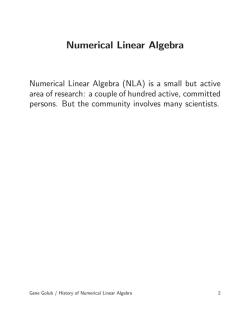
Numerical Linear Algebra Numerical Linear Algebra (NLA)is a small but active area of research:a couple of hundred active,committed persons.But the community involves many scientists. Gene Golub/History of Numerical Linear Algebra 2
Numerical Linear Algebra Numerical Linear Algebra (NLA) is a small but active area of research: a couple of hundred active, committed persons. But the community involves many scientists. Gene Golub / History of Numerical Linear Algebra 2
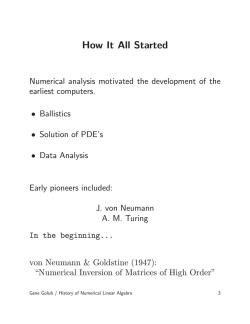
How It All Started Numerical analysis motivated the development of the earliest computers. ●Ballistics ●Solution of PDE's ●Data Analysis Early pioneers included: J.von Neumann A.M.Turing In the beginning.·. von Neumann Goldstine (1947): "Numerical Inversion of Matrices of High Order" Gene Golub/History of Numerical Linear Algebra
How It All Started Numerical analysis motivated the development of the earliest computers. • Ballistics • Solution of PDE’s • Data Analysis Early pioneers included: J. von Neumann A. M. Turing In the beginning... von Neumann & Goldstine (1947): “Numerical Inversion of Matrices of High Order” Gene Golub / History of Numerical Linear Algebra 3
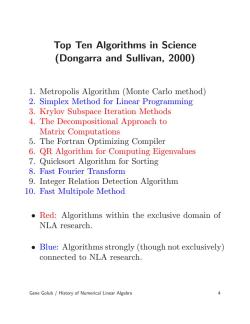
Top Ten Algorithms in Science (Dongarra and Sullivan,2000) 1.Metropolis Algorithm (Monte Carlo method) 2.Simplex Method for Linear Programming 3.Krylov Subspace Iteration Methods 4.The Decompositional Approach to Matrix Computations 5.The Fortran Optimizing Compiler 6.QR Algorithm for Computing Eigenvalues 7.Quicksort Algorithm for Sorting 8.Fast Fourier Transform 9.Integer Relation Detection Algorithm 10.Fast Multipole Method Red:Algorithms within the exclusive domain of NLA research. Blue:Algorithms strongly (though not exclusively) connected to NLA research. Gene Golub/History of Numerical Linear Algebra 4
Top Ten Algorithms in Science (Dongarra and Sullivan, 2000) 1. Metropolis Algorithm (Monte Carlo method) 2. Simplex Method for Linear Programming 3. Krylov Subspace Iteration Methods 4. The Decompositional Approach to Matrix Computations 5. The Fortran Optimizing Compiler 6. QR Algorithm for Computing Eigenvalues 7. Quicksort Algorithm for Sorting 8. Fast Fourier Transform 9. Integer Relation Detection Algorithm 10. Fast Multipole Method • Red: Algorithms within the exclusive domain of NLA research. • Blue: Algorithms strongly (though not exclusively) connected to NLA research. Gene Golub / History of Numerical Linear Algebra 4

Three important components in solving NLA problems Development and analysis of numerical algorithms ●Perturbation theory ●Software Gene Golub/History of Numerical Linear Algebra
Three important components in solving NLA problems • Development and analysis of numerical algorithms • Perturbation theory • Software Gene Golub / History of Numerical Linear Algebra 5
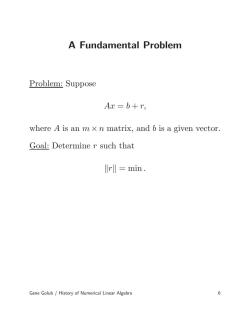
A Fundamental Problem Problem:Suppose Ax=b+r, where A is an m x n matrix,and b is a given vector. Goal:Determine r such that rll min. Gene Golub/History of Numerical Linear Algebra 6
A Fundamental Problem Problem: Suppose Ax = b + r, where A is an m × n matrix, and b is a given vector. Goal: Determine r such that krk = min . Gene Golub / History of Numerical Linear Algebra 6
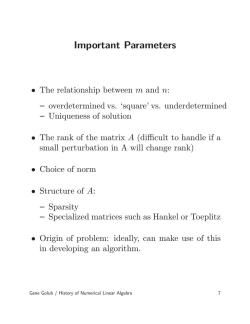
Important Parameters The relationship between m and n: overdetermined vs.'square'vs.underdetermined Uniqueness of solution The rank of the matrix A(difficult to handle if a small perturbation in A will change rank) 。Choice of norm ·Structure of A: -Sparsity Specialized matrices such as Hankel or Toeplitz Origin of problem:ideally,can make use of this in developing an algorithm. Gene Golub/History of Numerical Linear Algebra
Important Parameters • The relationship between m and n: – overdetermined vs. ‘square’ vs. underdetermined – Uniqueness of solution • The rank of the matrix A (difficult to handle if a small perturbation in A will change rank) • Choice of norm • Structure of A: – Sparsity – Specialized matrices such as Hankel or Toeplitz • Origin of problem: ideally, can make use of this in developing an algorithm. Gene Golub / History of Numerical Linear Algebra 7

Some Perturbation Theory Given Ax=6. and the perturbed system (A+△A)y=b+6, it can be shown that if N△AL≤e, deltal≤e, IA‖ b then lz-<2E·(A), Iz≤1-p where p=△A·IA-1‖=I△A‖·(A)/A‖<1, and (A)=‖A‖·‖A-1 Gene Golub/History of Numerical Linear Algebra 8
Some Perturbation Theory Given Ax = b, and the perturbed system (A + ∆A)y = b + δ, it can be shown that if k∆Ak kAk ≤ ε, kdeltak kbk ≤ ε, then kx − yk kxk ≤ 2ε 1 − ρ · κ(A), where ρ = k∆Ak · kA −1 k = k∆Ak · κ(A)/kAk < 1, and κ(A) = kAk · kA −1 k. Gene Golub / History of Numerical Linear Algebra 8
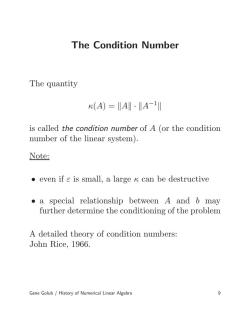
The Condition Number The quantity (A)=‖A‖·‖A-1‖ is called the condition number of A(or the condition number of the linear system). Note: even if s is small,a large k can be destructive a special relationship between A and 6 may further determine the conditioning of the problem A detailed theory of condition numbers: John Rice,1966. Gene Golub/History of Numerical Linear Algebra
The Condition Number The quantity κ(A) = kAk · kA −1 k is called the condition number of A (or the condition number of the linear system). Note: • even if ε is small, a large κ can be destructive • a special relationship between A and b may further determine the conditioning of the problem A detailed theory of condition numbers: John Rice, 1966. Gene Golub / History of Numerical Linear Algebra 9
按次数下载不扣除下载券;
注册用户24小时内重复下载只扣除一次;
顺序:VIP每日次数-->可用次数-->下载券;
- 《数值分析》课程教学资源(课外阅读)Professor SVD(Moler, 2006).pdf
- 《数值分析》课程教学资源(参考资料)Singular Values and Singular Value Inequalities(Mathias, Handbook of LA, 2014).pdf
- 华东师范大学:《数值分析》课程教学资源(课件讲义)第三讲 线性最小二乘问题——线性最小二乘问题的求解方法.pdf
- 华东师范大学:《数值分析》课程教学资源(课件讲义)第三讲 线性最小二乘问题——奇异值分解(SVD).pdf
- 华东师范大学:《数值分析》课程教学资源(课件讲义)第三讲 线性最小二乘问题——QR分解.pdf
- 华东师范大学:《数值分析》课程教学资源(课件讲义)第三讲 线性最小二乘问题——问题介绍与 Householder、Givens变换.pdf
- 华东师范大学:《数值分析》课程教学资源(课件讲义)第二讲 线性方程组直接解法——扰动分析与解的改进.pdf
- 《数值分析》课程教学资源(参考资料)Matrix factorizations and direct solution of linear systems(Beattie, Handbook of LA, 2014).pdf
- 《数值分析》课程教学资源(参考资料)Gaussian Elimination(Higham, 2011).pdf
- 华东师范大学:《数值分析》课程教学资源(课件讲义)第二讲 线性方程组直接解法——Gauss消去法与矩阵分解法.pdf
- 《数值分析》课程教学资源(文献资料)科学计算——科技创新的第三种方法(中国科学院:陈志明, 2012).pdf
- 《数值分析》课程教学资源(课外阅读)Is Numerical Analysis Boring(Sullivan, 2006).pdf
- 《数值分析》课程教学资源(课外阅读)The Best of the 20th Century - Editors Name Top 10 Algorithms(SIAM News, 2000).pdf
- 《数值分析》课程教学资源(课外阅读)Numerical Analysis(Trefethen, Princeton Companion to Mathematics, 2008).pdf
- 华东师范大学:《数值分析》课程教学资源(参考资料)IEEE浮点运算标准.pdf
- 华东师范大学:《数值分析》课程教学资源(课件讲义)第一讲 引论与预备知识——数值计算中的误差.pdf
- 华东师范大学:《数值分析》课程教学资源(课件讲义)第一讲 引论与预备知识——线性代数基础.pdf
- 《数值分析》课程教学资源(课件讲义)第一讲 引论与预备知识——数值分析引论 Numerical Analysis(主讲:潘建瑜).pdf
- 《数值分析》课程教学资源(学习资料)常用积分表(常用积分公式)Numerical Analysis.pdf
- 大学数学(参考资料)中学数学和微积分公式参考(英文).pdf
- 《数值分析》课程教学资源(课外阅读)Lloyd N. Trefethen, The Definition of Numerical Analysis, SIAM News, Nov 1992.pdf
- 《数值分析》课程教学资源(课外阅读)Lloyd N. Trefethen, Predictions for scientific computing 50 years from now, Mathematics Today, 2000.pdf
- 《数值分析》课程教学资源(课外阅读)数值计算指南, Sun Microsystems, Inc., 2005.pdf
- 大连大学:数学与应用数学(师范类)专业课程教学大纲汇编(2010).doc
- 大连大学:数学与应用数学(金融数学)专业课程教学大纲汇编(2010).doc
- 华东师范大学:《迭代方法与预处理》课程教学课件(迭代方法与预处理)第一讲 线性代数基础(矩阵基础).pdf
- 华东师范大学:《迭代方法与预处理》课程教学课件(迭代方法与预处理)第二讲 非负矩阵与M-矩阵.pdf
- 华东师范大学:《迭代方法与预处理》课程教学课件(迭代方法与预处理)第三讲 定常迭代法(主讲:潘建瑜).pdf
- 华东师范大学:《迭代方法与预处理》课程教学课件(迭代方法与预处理)第四讲 Krylov子空间方法.pdf
- 华东师范大学:《迭代方法与预处理》课程教学课件(迭代方法与预处理)第五讲 预处理方法.pdf
- 华东师范大学:《矩阵计算》课程教学资源(讲义)矩阵计算课堂讲义 Matrix Computations(主讲:潘建瑜).pdf
- 《矩阵计算》课程教学资源(文献资料)The decompositional approach to matrix computation(Stewart, 2000).pdf
- 《矩阵计算》课程教学资源(文献资料)G. H. Golub, History of Numerical Linear Algebra, a Personal View, 2007.pdf
- 《矩阵计算》课程教学资源(文献资料)Lloyd N. Trefethen, The Definition of Numerical Analysis, SIAM News, Nov 1992.pdf
- 《矩阵计算》课程教学资源(文献资料)Lloyd N. Trefethen, Predictions for scientific computing 50 years from now, Mathematics Today, 2000.pdf
- 上海交通大学:数学科学学院公共基础课《大学医科数学》课程教学大纲(A类,1).pdf
- 上海交通大学:数学科学学院公共基础课《大学医科数学》课程教学大纲(A类,2).pdf
- 上海交通大学:数学科学学院公共基础课《微积分基础》课程教学大纲.pdf
- 上海交通大学:数学科学学院公共基础课《数理方法》课程教学大纲.pdf
- 上海交通大学:数学科学学院公共基础课《概率统计》课程教学大纲.pdf
